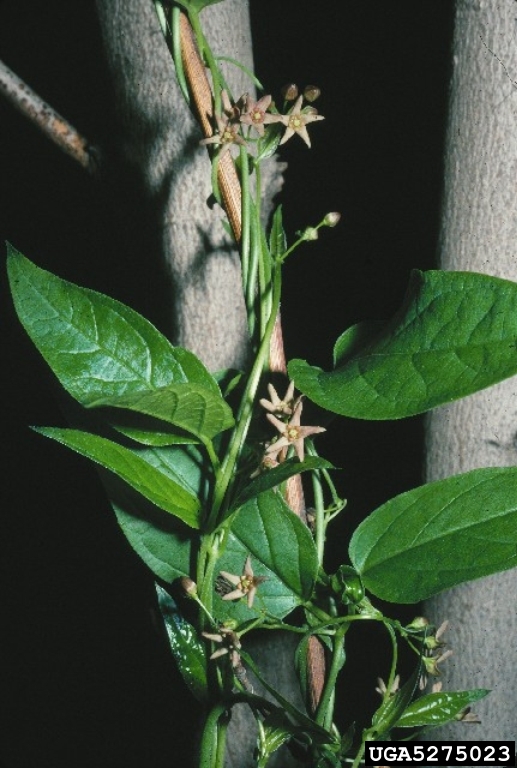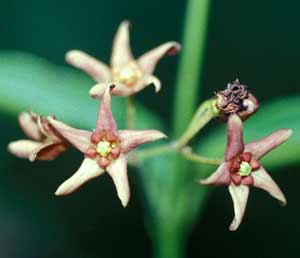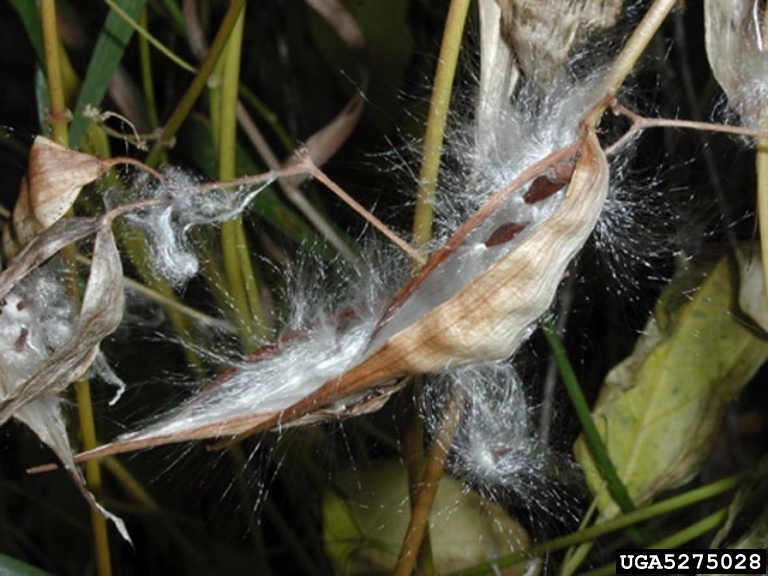 Download PDF
Download PDF
Name: Vincetoxicum rossicum (Kleopow) Barb.
Family: Apocynaceae (the dogbane family), yet formerly placed in the Asclepiadaceae (the milkweed family), depending on the taxonomist (1,2). Here we accept the larger Apocynaceae.
Common Names: European swallow-wort, pale swallow-wort (1), dog-strangling vine, dompte-venin de Russie (3).
Etymology: There are two explanations for the word Vincetoxicum. DiTommaso (3) explains that it comes from the Latin Vinco and toxicum, and means “to overcome or subdue [with] poison.” Fernald (13) says that Vincetoxicum is “an ancient name, meaning rope-like poison.” Rossicum, the specific epithet refers to its presumed origin in “Russia.”, the latinized form of the placename. The generic synonym Cynanchum is derived from the Greek words kyon, meaning “dog”, and anchein, meaning “strangle” or “poison.” This generic name possibly refers to a past use of the plant as an animal poison.
Botanical synonyms: Cynanchum rossicum, Cynanchum medium, Vincetoxicum medium, Vincetoxicum hirundinaria (1,3,6,11,12,15).
Quick Notable Features:
¬ Linear bands of pubescence on the stem
¬ Stems and leaves with latex
¬ Pale pink to maroon flowers, slightly fleshy, with a corona
Plant Height: The stems are typically 0.6-2.5m long. It can twine as high as 0.8m (3,6,8,10,11,14).
Subspecies/varieties recognized: None found in the literature (1,3).
Most Likely Confused with: Viburnum spp., Solanum dulcamara, Vincetoxicum nigrum, Lonicera spp.
Habitat Preference: It occupies a variety of habitats, from the very disturbed (railroads, roadsides, fields, pastures, quarries, fencerows etc.) to the less disturbed (beech-maple, oak, ash forests). The species is not so dense or dominating in habitats with less light (17). Its native habitat is grasslands, rocky hills, and ravine slopes, in calcareous or alkaline soils (3,8,13,14).
Geographic Distribution in Michigan: Found in Berrien, Oakland, Van Buren, and Washtenaw counties (1,22).
Known Elevational Distribution: None found in the literature, however herbarium specimens indicate that the species grow from 0 to at least 319m above sea level in Ontario, Canada (20).
Complete Geographic Distribution: The species has a distinctly northern distribution. The first description of V. rossicum came from the Ukraine near Kiev. The pale swallow-wort is now found in France, Greece, Norway, Sweden, and Turkey (20), however it is thought to be endemic only to the Caucasus and Black Sea region (3). In the United States, V. rossicum is now found throughout most of New England, as well as Indiana, Michigan, Ohio, and Pennsylvania. In Canada it is found in British Columbia, Ontario, and Quebec (1,3). 
Vegetative Plant Description: A perennial herbaceous scrambler, erect forb, or twining vine that over-winters as short, horizontal rhizomes. The roots are pale, fibrous, and fleshy. The opposite leaves are 7-13cm long and 5-8cm wide, ovate-lanceolate to elliptic and acuminate-acute with entire margins, growing smallest near the stem base and apices, and largest in the middle of the stem. The leaf margins and major veins are pubescent on the lower surface. The petioles are 5-20mm long (3,6,8,9,11,13,14).
Climbing Mechanism: The species twines with its apex (3,9). No twining orientation was found in the literature, but photographs indicate V. rossicum twines in a dextral direction (left to right).
Flower Description: Each cymose inflorescence contains 5-20 flowers, produced in a leaf axil. The peduncles are 1-5cm long and pubescent in linear bands. The pedicels are also pubescent, bearing 5-merous flowers that are pale pink, red, or maroon. The sepals are 1-1.5mm long, and slender. The petals are slightly fleshy, 2.5-5mm long, 1.25-2.5mm wide, and glabrous with translucent margins. The distinctly-lobed corona is typically a bit darker than the corolla, but can also be orange, or yellow. The gynostegium (a fusion of the androecium and gynoecium) is pale and green or yellow-green. The flower buds are conical (3,6,8,9,11,13,14).
Flowering Time: Observed in central New York flowering from mid-May to early June (3).
Pollinator: Flies, ants, bees, wasps, and beetles were all observed to pollinate the flower, which is described as sweetly fragrant (3). V. rossicum is also capable of self-pollination (21).
Fruit Type and Description: Each flower of V. rossicum can produce 1 or 2 glabrous, fusiform follicles, approximately 4-7cm long and “slender.” In central New York, the fruits are observed as early as the first week of June (3,6,9).
Seed Description: Light or dark brown and flattened, 4-6.5mm wide and 2.4-3.1mm long, oblong or obovoid. The surface can be smooth or wrinkly. Each seed has an apical coma (plume of hairs) 2-3cm long (3,9,10). Polyembryony (multiple embryos per seed) is reported as common (15,19). Seed germination has been reported as close to or greater than 50% under ideal growth condition (16,17).
Dispersal Syndrome: The follicles dehisce, dispersing the tufted seeds (3,9). It is noted that reproduction is largely via seeds, rather than via rhizomes (9,10).
Distinguished by: Many Apocynaceae, including Vincetoxicum, can be distinguished from most other families by the presence of milky latex in the stems. While both Lonicera and Vincetoxicum are simple and opposite-leaved, no climbing Lonicera species in Michigan has latex in its stem. Climbing Lonicera species often have semi-woody stems. Furthermore, the flowers of Lonicera are usually strongly zygomorphic, whereas Vincetoxicum has actinomorphic flowers (2,11).
V. rossicum may be distinguished from Solanum dulcamara by its opposite, entire leaves (Solanum has alternate, serrate/lobed leaves) and fruit (V. rossicum has a follicle; S. dulcamara has a bright red berry) (11).
V. rossicum has pale pink, occasionally maroon flowers, with glabrous petals at least twice as long as wide, unlike V. nigrum (sometimes known as Cynanchum louiseae) whose dark purple petals are about at long as they are wide, with adaxial surfaces pubescent. Furthermore, the flower buds of V. rossicum are conical, whereas the flower buds of V. nigrum are globose. Finally, the linear bands of hair on the stems of V. rossicum are much more distinct and dense than the bands of pubescence on V. nigrum  (3,11,14,18).
(3,11,14,18).
Other members of the family in Michigan: Asclepias (12 spp.) and Vincetoxicum (1 sp.) in the Asclepiadaceae s.s. If Apocynaceae and Asclepiadaceae are treated as one family, as here, that adds Apocynum (3 species) and Vinca (2 species) to the family totals (source: 1).
Ethnobotanical Uses: None found, with the exception of the etymology mentioned above: Cynanchum (earlier synonym) comes from the Greek words kyon, meaning “dog”, and anchein, meaning “strangle” or “poison.” The name possibly refers to a possible past use of the plant as an animal poison, as well as its presumed origin. Interestingly, the Latin Vinco and toxicum, from which came the synonym Vincetoxicum, roughly means “to overcome or subdue [with] poison” (3).
 Phylogenetic Information: Apocynaceae and Asclepiadaceae are sometimes treated as distinct families, but since 1962 have been merged by many workers, with Asclepiadoideae as one of five subfamilies within Apocynaceae. There are several differences (as well as similarities), but a few distinguishing characters may be useful in the field: corolla shape (generally rotate in Asclepiadaceae and funnelform or salverform in Apocynaceae), and filament fusion (typically connate in Asclepiadaceae, and distinct in Apocynaceae). The family Apocynaceae is placed in the Gentianales, within the Asterid I group of the angiosperms (2,7).
Phylogenetic Information: Apocynaceae and Asclepiadaceae are sometimes treated as distinct families, but since 1962 have been merged by many workers, with Asclepiadoideae as one of five subfamilies within Apocynaceae. There are several differences (as well as similarities), but a few distinguishing characters may be useful in the field: corolla shape (generally rotate in Asclepiadaceae and funnelform or salverform in Apocynaceae), and filament fusion (typically connate in Asclepiadaceae, and distinct in Apocynaceae). The family Apocynaceae is placed in the Gentianales, within the Asterid I group of the angiosperms (2,7).
Interesting Quotation or Other Interesting Factoid not inserted above: V. rossicum often becomes highly invasive where it escapes, including Norway, southern Canada, and parts of the U.S. It is invasive and/or prohibited in the Great Lakes area as well as in Connecticut, Massachusetts, New Hampshire, New York, and Wisconsin (1,3,15,17).
Several species of butterfly, including the North American monarch butterfly (Danaus plexippus), lay their eggs exclusively on members of Asclepiadaceae. Although some butterfly species show a clear preference for non-toxic Asclepiadaceae species (primarily Asclepias) when they are available, some butterflies have been observed to lay their eggs on V. rossicum, raising concerns about the survival of the populations due to the toxic nature of compounds of V. rossicum and its recent rapid spread (5, 15). A study of arthropod populations in old fields with V. rossicum found the presence of the species to have a negative impact on the arthropod populations (4).
V. rossicum’s potential range may occur beyond areas that experience similar temperatures to its current native range. A study in Ontario, Canada suggests that the species can thrive in colder climates and spread further north. Competition with native species may slow V. rossicum expansion by decreasing its seed size (21).
Literature and websites used:
- USDA, NRCS. 2014. The PLANTS Database (http://plants.usda.gov, 7 February 2014). National Plant Data Team, Greensboro, NC 27401-4901 USA.
- Zomlefer, W.B. 1994. Guide to Flowering Plant Families. Chapel Hill, North Carolina, USA: The University of North Carolina.
- DiTommaso, A., F.M. Lawlor, & S.J. Darbyshire 2005. The Biology of Invasive Alien Plants in Canada, Cynanchum rossicum (Kleopow) Borhidi [= Vincetoxicum rossicum (Kleopow) Barbar.] and Cynanchum louiseae (L.) Kartesz & Gandhi [= Vincetoxicum nigrum (L.) Moench]. Canadian Journal of Plant Science 85: 243-263.
- Ernst, C.M. & N. Cappucino 2005. The effect of an invasive alien vine, Vincetoxicum rossicum (Asclepiadaceae), on arthropod populations in Ontario old fields. Biological Invasion 7(3): 417-425.
- Casagrande, R.A. & J.E. Dacey. 2007. Monarch Butterfly Oviposition on Swallow-Worts (Vincetoxicum spp.). Environmental Entomology 36: 631-636.
- Kaufman, S.R. 2007. Invasive Plants: Common Species, Their Role in Nature and Economy, and Controls. Mechanicsburg, Pennsylvania: Stackpole Books.
- ANGIOSPERM PHYLOGENY GROUP 2003. An update of the Angiosperm Phylogeny Group classification for the orders and families of flowering plants: APG II. Botanical Journal of the Linnean Society 141(4): 399-436.
- Wisconsin Department of Natural Resources. Pale Swallow-wort (Vincetoxicum rossicum; syn. Cynanchum rossicum). Last revised: September 3, 2004. http://dnr.wi.gov/invasives/fact/swallowwort_pale.htm (December 12, 2008)
- Weston, L.A., J.N. Barney, & A. DiTommaso. 2005. A review of the biology and ecology of three invasive perennials in New York State: Japanese knotweed (Polygonum cuspidatum), mugwort (Artemisia vulgaris) and pale swallow-wort (Vincetoxicum rossicum). Plant and Soil 277: 53-69.
- Bojnansky, V. & A. Fargasova 2007. Atlas of Seeds and Fruits of Central and East-European Flora. New York City, NY, USA: Springer.
- Gleason, H.A. & A. Cronquist 1991. Manual of Vascular Plants of the Northeastern United States and Adjacent Canada. Bronx, New York: New York Botanical Garden Press.
- Voss, E.G. 2004. Michigan Flora Part III: Dicots Concluded. Ann Arbor, Michigan, USA: Cranbrook Institute of Science.
- Fernald, M.L. 1950. Gray’s Manual of Botany, 8th ed. New York, USA: American Book Company.
- Uva, R.H., J.C. Neal, & J.M. DiTomaso 1997. Weeds of the Northeast. Ithaca, New York: Cornell University Press.
- Hotchkiss, E.E., A. DiTommaso, D.C. Brainard, & C.L. Mohler 2008. Survival and performance of the invasive vine Vincetoxicum rossicum (Apocynaceae) from seeds of different embryo number under two light environments. American Journal of Botany 95(4):447-453.
- Cappuccino, N., R. MacKay, & C. Eisner 2002. Spread of the invasive alien Vincetoxicum rossicum: tradeoffs between seed dispersability and seed quality. American Midland Naturalist 148:263-270.
- Smith, L.L., A. DiTommaso, J. Lehmann, & S. Greipsson 2006. Growth and reproductive potential of the invasive exotic vine Vincetoxicum rossicum in northern New York State. Canadian Journal of Botany 84:1771-1780.
- Sheeley, S.E. & D.J. Raynal 1996. The distribution and status of species of Vincetoxicum in Eastern North America. Bulletin of the Torrey Botanical Club 123(2):148-156.
- Blanchard, M.L., J.N. Barney, K.M. Averill, C.L. Mohler & A. DiTommaso 2010. Does polyembryony confer a competitive advantage to the invasive perennial vine Vincetoxicum rossicum (Apocynaceae)? American Journal of Botany 97(2): 251–260.
- Gbif.org. Global Biodiversity Information Facility Website. Accessed: 02 December 2013.
- Sanderson, L.A. & P.M. Antunes 2013. The exotic invasive plant Vincetoxicum rossicum is a strong competitor even outside its current realized climatic temperature range. NeoBiota 16: 1-15.
- Michigan Flora Online. A.A. Reznicek, E.G. Voss, & B.S. Walters. February 2011. University of Michigan. Web. February 7, 2014. http://michiganflora.net/species.aspx?id=168.
Image Credits (all used with permission):
1. Image of twining plant courtesy Leslie J. Mehrhoff, University of Connecticut, Bugwood.org (http://www.invasive.org/browse/detail.cfm?imgnum=5275023).
2. Image of plant habit is courtesy Leslie J. Mehrhoff, University of Connecticut, Bugwood.org (http://www.invasive.org/browse/detail.cfm?imgnum=5275025).
3. Image of flower close up is ©John M. Randall/The Nature Conservancy archived at http://www.nps.gov/plants/alien/fact/cyro1.htm
4. Image of seed dispersing courtesy Leslie J. Mehrhoff, University of Connecticut, Bugwood.org (http://www.invasive.org/browse/detail.cfm?imgnum=5275028).
5. Species distribution map, derived from the Michigan Flora Online.
Primary Author: ReBecca Sonday and John Bradtke with additions from Robyn J. Burnham & Cristine V. Santanna.
© Robyn J. Burnham
For additional information on Michigan Plant Diversity web pages please contact Robyn J. Burnham via email: rburnham“at”umich.edu